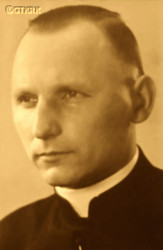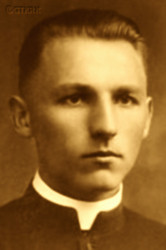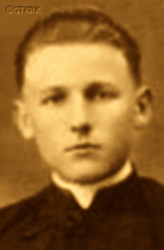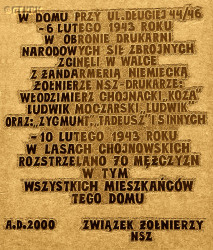Roman Catholic
St Sigismund parish
05-507 Słomczyn
85 Wiślana Str.
Konstancin deanery
Warsaw archdiocese, Poland
full list:
displayClick to display full list

searchClick to search full list by categories
wyświetlKliknij by wyświetlić pełną listę po polsku

szukajKliknij by przeszukać listę wg kategorii po polsku

Martyrology of the clergy — Poland
XX century (1914 – 1989)
personal data
surname
NIEDZIAŁEK
forename(s)
John (pl. Jan)
function
diocesan priest
creed
Latin (Roman Catholic) Church RCmore on
en.wikipedia.org
[access: 2014.09.21]
diocese / province
Siedlce diocesemore on
en.wikipedia.org
[access: 2022.01.06]
RC Military Ordinariate of Polandmore on
en.wikipedia.org
[access: 2014.12.20]
academic distinctions
Doctor of Philosophy
Doctor of Theology
date and place
of death
12.02.1943

Chojnowskie forestsn. Stefanów
today: Piaseczno gm., Piaseczno pov., Masovia voiv., Poland
more on
en.wikipedia.org
[access: 2022.01.28]
alt. dates and places
of death
13.02.1942
details of death
After German and Russian invasion of Poland in 09.1939 and the beginning of World War II, after the start of German occupation, evicted by the Germans on 23‐25.11.1939, along with all professors and seminarians, from the building of the Theological Seminary in Janów Podlaski.
The seminary ceased to operate.
Took the position of vicar in Żelechów.
There made contact with the clandestine resistance National Party SN organization and its military arm, the National Military Organization NOW.
After being transferred to Siedlce in 1941, where became the professor of the clandestine Theological Seminary of his diocese, continued his ministry as a chaplain of the NOW District Command and head of the SN District Propaganda Department.
Distributed national underground magazines, incl.
„Struggle”.
Was one of the initiators of propaganda diversion among Italian army soldiers stationed in Siedlce.
In the second half of 1942, took part in talks that were to lead to the merger of NOW units with the clandestine Home Army AK, as part of the Polish Clandestine State.
Arrested by the Germans on 16.01.1943 during a round–up on a train while on his way back from Warsaw.
The Germans began searches at the Mrozy station and found his luggage, containing conspiratorial publications — at the Siedlce station, in order to protect other travelers from consequences, confessed to his ownership.
Imprisoned in Siedlce.
Tortured.
Then, after a week, transferred to Pawiak prison in Warsaw.
Interrogated at the Germ. Geheime Staatspolizei (Eng. Secret State Police), i.e. Gestapo, headquarters at Szucha Ave. — tortured again.
Did not reveal any names and did not denounce anyone.
Murdered in a mass execution of 70 Poles — in retaliation for the shooting during German raid on a clandestine printing house belonging to the National Armed Forces NSZ.
The Germans informed about the execution by posting an announcement on the streets of Warsaw, dated 12.02.1943.
alt. details of death
After end of World War II military conflict the bodies of murdered were brought and buried on 24‐25.06.1948 at Cemetery–Mausoleum in Palmiry n. Warsaw.
cause of death
mass murder
perpetrators
Germans
sites and events
PalmiryClick to display the description, Chojnowskie forestClick to display the description, Warsaw (Szuch Ave.)Click to display the description, PawiakClick to display the description, Street round‐upClick to display the description, GeneralgouvernementClick to display the description, Ribbentrop‐MolotovClick to display the description, Pius XI's encyclicalsClick to display the description
date and place
of birth
22.12.1907

Żeliszewtoday: Żeliszew Podkościelny and Żeliszew Duży, Kotuń gm., Siedlce pov., Masovia voiv., Poland
more on
en.wikipedia.org
[access: 2022.01.28]
presbyter (holy orders)
ordination
02.08.1931

Siedlcetoday: Siedlce city pov., Masovia voiv., Poland
more on
en.wikipedia.org
[access: 2021.08.20]
Immaculate Conception of the Blessed Virgin Mary RC cathedral churchmore on
pl.wikipedia.org
[access: 2021.07.04]
positions held
1941 – 1943
curatus/rector/expositus — Siedlcetoday: Siedlce city pov., Masovia voiv., Poland
more on
en.wikipedia.org
[access: 2021.08.20] ⋄ RC chapel (oratory of St Therese of the Child Jesus' Sodality of Catholic Women Workers „Unity”) ⋄ Immaculate Conception of the Blessed Virgin Mary RC cathedral parish ⋄ Siedlcetoday: Siedlce city pov., Masovia voiv., Poland
more on
en.wikipedia.org
[access: 2021.08.20] RC deanery
1941 – 1943
professor — Siedlcetoday: Siedlce city pov., Masovia voiv., Poland
more on
en.wikipedia.org
[access: 2021.08.20] ⋄ clandestine Theological Seminary — lecturer in Christian philosophy
1939 – 1941
vicar — Żelechówtoday: Żelechów gm., Garwolin pov., Masovia voiv., Poland
more on
en.wikipedia.org
[access: 2022.06.13] ⋄ Annunciation to the Blessed Virgin Mary RC parish ⋄ Żelechówtoday: Żelechów gm., Garwolin pov., Masovia voiv., Poland
more on
en.wikipedia.org
[access: 2022.06.13] RC deanery
1932 – 1939
professor — Janów Podlaskitoday: Janów Podlaski gm., Biała Podlaska pov., Lublin voiv., Poland
more on
en.wikipedia.org
[access: 2021.12.18] ⋄ Theological Seminary — also: prefect (c. 1935‐1937), secretary (c. 1932‐1935, c. 1938‐1939)
1938 – c. 1939
pro–synodal judge — Siedlcetoday: Siedlce city pov., Masovia voiv., Poland
more on
en.wikipedia.org
[access: 2021.08.20] ⋄ Bishop's Diocesan Court
membership — Management Board, District of the National Party
1927 – 1932
PhD student — Rometoday: Rome prov., Lazio reg., Italy
more on
en.wikipedia.org
[access: 2021.12.18] ⋄ philosophy and theology, Department of Theology, „Gregorianum” [i.e. Lat. Pontificia Universitas Gregoriana (Eng. Pontifical Gregorian University)] — PhD thesis in philosophy, public defense on 14.01.1929, theology PhD thesis, public defense in 1932; resident: Pontifical Polish College (Lat. Pontificium Collegium Polonorum) at Via dei Maroniti
1926 – 1927
student — Rometoday: Rome prov., Lazio reg., Italy
more on
en.wikipedia.org
[access: 2021.12.18] ⋄ theology, Department of Theology, „Gregorianum” [i.e. Lat. Pontificia Universitas Gregoriana (Eng. Pontifical Gregorian University)] — basic level studies, completed on 04.07.1927 „summa cum laude” and crowned with the title of bachelor; resident: Pontifical Polish College (Lat. Pontificium Collegium Polonorum) at 22 Via dei Maroniti on Quirinal Hill
1925 – 1926
student — Janów Podlaskitoday: Janów Podlaski gm., Biała Podlaska pov., Lublin voiv., Poland
more on
en.wikipedia.org
[access: 2021.12.18] ⋄ philosophy and theology, Theological Seminary
sites and events
descriptions
Palmiry: From 12.1939 till 07.1941 Germany — units of genocidal SS and Germ. Schutzpolizei (Eng. preventive police), i.e. Schupo —‐ in mass executions, murdered in Palmiry c. 1,700‐2,200 Poles from Warsaw, mainly the intelligentsia, as part of the «AB‐aktion», as well as Jews. The first executions took place on December 07‐08.12.1939 (70+80 victims). Among the biggest were: 26.02.1940 — c. 190 people; 02.04.1940 — c. 100. The victims were brought to the execution site by trucks, usually at dawn. Their luggage was collected at the site. Sometimes were restrained and/or blindfolded. Next were led to the edge of the dug pits where they were shot with machine gun fire. Those giving signs of life were finished off with small arms. The pits were filled in and pine thickets planted. (more on: en.wikipedia.orgClick to attempt to display webpage
[access: 2022.08.17])
Chojnowskie forest: Place of mass murder of Polish prisoner in 01‐02.1943. Germans executed there approx. 109 people, mainly from Warsaw, as part of an organized terror campaign launched against Warsaw in the winter of 1942/1943. (more on: pl.wikipedia.orgClick to attempt to display webpage
[access: 2021.12.19])
Warsaw (Szuch Ave.): At 25 John Christian Szuch Avenue in Warsaw — then in German‐occupied Germ. Generalgouvernement (Eng. General Governorate) — at the heart of so‐called police district (with status Germ. „Nur für Deutsche” — End. „Only for Germans”), from 07.10.1939 headquarters of Germ. Der Kommandeur Sicherheitspolizei und des Sicherheitsdienst für den Distrikt Warschau (Eng. Bureau of Security Police and Security Service Commander for Warsaw District), Germans organised Warsaw HQ of Germ. Geheime Staatspolizei (Eng. Secret State Police), i.e. Gestapo. In the basements a Germ. Hausgefängnis (Eng. Detention Centre) was set. Prisoners from Warsaw prisons, mainly Pawiak (twice a day) where brought there for interrogations. Tortures were widely used — „beating (with a club, whip, rubber, iron poles, butts of pistols), kicking, setting dogs on, burning flesh with cigarettes or an iron rod (especially the face, heels and abdomen), crushing fingers and genitals, hanging on the hands at the back, breaking bones, knocking out front teeth, damaging eyeballs, strangling with a gas mask with a damaged absorber, irritating with electric current, pouring water into the nose with gagged mouth, dipping the prisoner's head in a bucket with water and holding it there until signs of suffocation, plucking out nails and driving steel needles under them” (Wikipedia). Often tortures were done with family members present. Even women in last months of pregnancy were tortured. During Warsaw Uprising of 08‐10.1944 Germans conducted mass executions in the building. Number of victims — unknown (in 06.1946 in Szucha Avenue building basements 5.5. tons of human ashes and bones were discovered). (more on: en.wikipedia.orgClick to attempt to display webpage
[access: 2019.02.02])
Pawiak: Investigative prison in Warsaw, built by the Russian occupiers of Poland in 1830‐1835. During the Poland partition's period, a Russian investigative prison, both criminal and political. During World War II and the German occupation, the largest German prison in the Germ. Generalgouvernement (Eng. General Governorate). Initially, it was subordinate to the Justice Department of the General Governorate, and from 03.1940 Germ. Sicherheitspolizei und des Sicherheitsdienst (Eng. Security Police and Security Service) of the Warsaw District — in particular the German Secret Political Police Gestapo. c. 3,000 prisoners were kept in Pawiak permanently, of which about 2,200 in the men's unit and c. 800 in the women's unit (the so‐called Serbia) — with a „capacity” of c. 1,000 prisoners. In total, in the years 1939‐1944, c. 100,000 Poles passed through the prison, of which c. 37,000 were murdered in executions — from 10.1943 Pawiak prisoners were murdered in open executions on the streets of Warsaw (sometimes several times a day) — during interrogations, in cells or in a prison „hospital”, and c. 60,000 were taken in 95 transports to concentration camps (mainly KL Auischwitz), other places of isolation or to forced labor. The prison Germans demolished during the Warsaw Uprising in 08‐10.1944. (more on: en.wikipedia.orgClick to attempt to display webpage
[access: 2022.08.17])
Street round‐up: Ambush method used by Germans to capture a larger number of random passers on the streets of occupied Polish towns and cities in order to imprison them (that sometimes ended with public executions), resettle, sent to concentration camps or to a forced labor in Germany. (more on: en.wikipedia.orgClick to attempt to display webpage
[access: 2015.04.18])
Generalgouvernement: After the Polish defeat in the 09.1939 campaign, which was the result of the Ribbentrop‐Molotov Pact and constituted the first stage of World War II, and the beginning of German occupation in part of Poland (in the other, eastern part of Poland, the Russian occupation began), the Germans divided the occupied Polish territory into five main regions. In two of them new German provinces were created, two other were incorporated into other provinces. However, the fifth part was treated separately, and in a political sense it was supposed to recreate the German idea from 1915 (during World War I, after the defeat of the Russians in the Battle of Gorlice in 05.1915) of creating a Polish enclave within Germany. Illegal in the sense of international law, i.e. Hague Convention, and public law, managed by the Germans according to separate laws — especially established for the Polish Germ. Untermenschen (Eng. subhumans) — till the Russian offensive in 1945 it constituted part of the Germ. Großdeutschland (Eng. Greater Germany). Till 31.07.1940 formally called Germ. Generalgouvernement für die besetzten polnischen Gebiete (Eng. General Government for the occupied Polish lands) — later simply Germ. Generalgouvernement (Eng. General Governorate), as in the years 1915‐1918. From 07.1941, i.e. after the German attack on 22.06.1941 against the erstwhile ally, the Russians, it also included the Galicia district, i.e. the Polish pre‐war south‐eastern voivodeships. A special criminal law was enacted and applied to Poles and Jews, allowing for the arbitrary administration of the death penalty regardless of the age of the „perpetrator”, and sanctioning the use of collective responsibility. After the end of the military conflict of the World War UU, the government of the Germ. Generalgouvernement was recognized as a criminal organization, and its leader, governor Hans Frank, guilty of war crimes and crimes against humanity and executed. (more on: en.wikipedia.orgClick to attempt to display webpage
[access: 2024.12.13])
Ribbentrop‐Molotov: Genocidal Russian‐German alliance pact between Russian leader Joseph Stalin and German leader Adolf Hitler signed on 23.08.1939 in Moscow by respective foreign ministers, Mr. Vyacheslav Molotov for Russia and Joachim von Ribbentrop for Germany. The pact sanctioned and was the direct cause of joint Russian and German invasion of Poland and the outbreak of the World War II in 09.1939. In a political sense, the pact was an attempt to restore the status quo ante before 1914, with one exception, namely the „commercial” exchange of the so‐called „Kingdom of Poland”, which in 1914 was part of the Russian Empire, fore Eastern Galicia (today's western Ukraine), in 1914 belonging to the Austro‐Hungarian Empire. Galicia, including Lviv, was to be taken over by the Russians, the „Kingdom of Poland” — under the name of the General Governorate — Germany. The resultant „war was one of the greatest calamities and dramas of humanity in history, for two atheistic and anti‐Christian ideologies — national and international socialism — rejected God and His fifth Decalogue commandment: Thou shall not kill!” (Abp Stanislav Gądecki, 01.09.2019). The decisions taken — backed up by the betrayal of the formal allies of Poland, France and Germany, which on 12.09.1939, at a joint conference in Abbeville, decided not to provide aid to attacked Poland and not to take military action against Germany (a clear breach of treaty obligations with Poland) — were on 28.09.1939 slightly altered and made more precise when a treaty on „German‐Russian boundaries and friendship” was agreed by the same murderous signatories. One of its findings was establishment of spheres of influence in Central and Eastern Europe and in consequence IV partition of Poland. In one of its secret annexes agreed, that: „the Signatories will not tolerate on its respective territories any Polish propaganda that affects the territory of the other Side. On their respective territories they will suppress all such propaganda and inform each other of the measures taken to accomplish it”. The agreements resulted in a series of meeting between two genocidal organization representing both sides — German Gestapo and Russian NKVD when coordination of efforts to exterminate Polish intelligentsia and Polish leading classes (in Germany called «Intelligenzaktion», in Russia took the form of Katyń massacres) where discussed. Resulted in deaths of hundreds of thousands of Polish intelligentsia, including thousands of priests presented here, and tens of millions of ordinary people,. The results of this Russian‐German pact lasted till 1989 and are still in evidence even today. (more on: en.wikipedia.orgClick to attempt to display webpage
[access: 2015.09.30])
Pius XI's encyclicals: Facing the creation of two totalitarian systems in Europe, which seemed to compete with each other, though there were more similarities than contradictions between them, Pope Pius XI issued in 03.1937 (within 5 days) two encyclicals. In the „Mit brennender Sorge” (Eng. „With Burning Concern”) published on 14.03.1938, condemned the national socialism prevailing in Germany. The Pope wrote: „Whoever, following the old Germanic‐pre‐Christian beliefs, puts various impersonal fate in the place of a personal God, denies the wisdom of God and Providence […], whoever exalts earthly values: race or nation, or state, or state system, representatives of state power or other fundamental values of human society, […] and makes them the highest standard of all values, including religious ones, and idolizes them, this one […] is far from true faith in God and from a worldview corresponding to such faith”. On 19.03.1937, published „Divini Redemptoris” (Eng. „Divine Redeemer”), in which criticized Russian communism, dialectical materialism and the class struggle theory. The Pope wrote: „Communism deprives man of freedom, and therefore the spiritual basis of all life norms. It deprives the human person of all his dignity and any moral support with which he could resist the onslaught of blind passions […] This is the new gospel that Bolshevik and godless communism preaches as a message of salvation and redemption of humanity”… Pius XI demanded that the established human law be subjected to the natural law of God , recommended the implementation of the ideal of a Christian state and society, and called on Catholics to resist. Two years later, National Socialist Germany and Communist Russia came together and started World War II. (more on: www.vatican.vaClick to attempt to display webpage
[access: 2023.05.28], www.vatican.vaClick to attempt to display webpage
[access: 2023.05.28])
sources
personal:
www.genealogia.okiem.plClick to attempt to display webpage
[access: 2012.11.23], www.polacyizydzi.plClick to attempt to display webpage
[access: 2013.02.15], echokatolickie.plClick to attempt to display webpage
[access: 2013.02.15], www.echokatolickie.plClick to attempt to display webpage
[access: 2013.08.10]
original images:
echokatolickie.plClick to attempt to display webpage
[access: 2013.02.15], www.siedlce-zwiedzanie.plClick to attempt to display webpage
[access: 2015.05.09], www.siedlce-zwiedzanie.plClick to attempt to display webpage
[access: 2015.05.09], commons.wikimedia.orgClick to attempt to display webpage
[access: 2015.05.09]
LETTER to CUSTODIAN/ADMINISTRATOR
If you have an Email client on your communicator/computer — such as Mozilla Thunderbird, Windows Mail or Microsoft Outlook, described at WikipediaPatrz:
en.wikipedia.org, among others — try the link below, please:
LETTER to CUSTODIAN/ADMINISTRATORClick and try to call your own Email client
If however you do not run such a client or the above link is not active please send an email to the Custodian/Administrator using your account — in your customary email/correspondence engine — at the following address:

giving the following as the subject:
MARTYROLOGY: NIEDZIAŁEK John
To return to the biography press below:
 Click to return to biography
Click to return to biography











